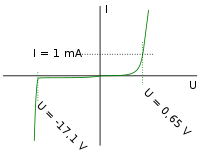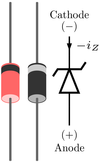Electronics Handbook/Components/Diodes/Zener
This kind of diode conducts in both the forward and backward directions. When it conducts in the backward direction it operates as a voltage regulator. When it conducts in the forward direction it operates like a PN diode.
| Symbol | I - V Curve | Construction |
|---|---|---|
 |

|
Operation
editWhen biased voltage on Diode is negative the diode's junction is punched through . Further increase in voltage until voltage reaches Break Down Voltage level . Current remains constant does not change with increasing voltage . Further increase voltage above this point Diode will break down
Applications
editVoltage Regulator
editZener diodes are widely used to regulate the voltage across a circuit. When connected in parallel with a variable voltage source so that it is reverse biased, a Zener diode conducts when the voltage reaches the diode's reverse breakdown voltage. From that point it keeps the voltage at that value.
In the circuit shown, resistor R provides the voltage drop between UIN and UOUT. The value of R must satisfy two conditions:
- R must be small enough that the current through D keeps D in reverse breakdown. The value of this current is given in the data sheet for D. For example, the common BZX79C5V6[1] device, a 5.6 V 0.5 W Zener diode, has a recommended reverse current of 5 mA. If insufficient current exists through D, then UOUT will be unregulated, and less than the nominal breakdown voltage (this differs to voltage regulator tubes where the output voltage will be higher than nominal and could rise as high as UIN). When calculating R, allowance must be made for any current through the external load, not shown in this diagram, connected across UOUT.
- R must be large enough that the current through D does not destroy the device. If the current through D is ID, its breakdown voltage VB and its maximum power dissipation PMAX, then .
A Zener diode used in this way is known as a shunt voltage regulator (shunt, in this context, meaning connected in parallel, and voltage regulator being a class of circuit that produces a stable voltage across any load). In a sense, a portion of the current through the resistor is shunted through the Zener diode, and the rest is through the load. Thus the voltage that the load sees is controlled by causing some fraction of the current from the power source to bypass it—hence the name, by analogy with locomotive switching points.
These devices are also encountered, typically in series with a base-emitter junction, in transistor stages where selective choice of a device centered around the avalanche/Zener point can be used to introduce compensating temperature co-efficient balancing of the transistor PN junction. An example of this kind of use would be a DC error amplifier used in a stabilized power supply circuit feedback loop system.
Because it is almost always the reverse-breakdown property of the Zener diode that is useful, in circuit schematics the Zener diode symbol (i.e., a diode arrow) typically points in the opposite direction of the circuit's positive current flow. This use is opposite that of a typical diode, which would be aligned with the current flow.